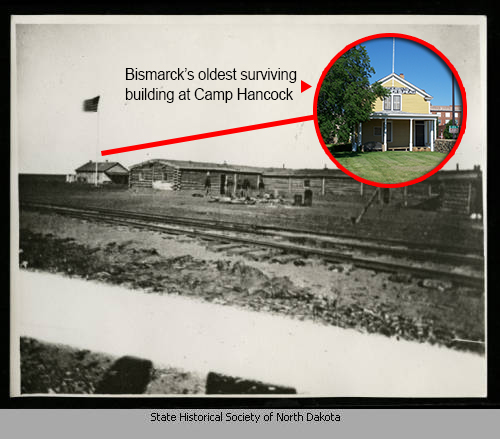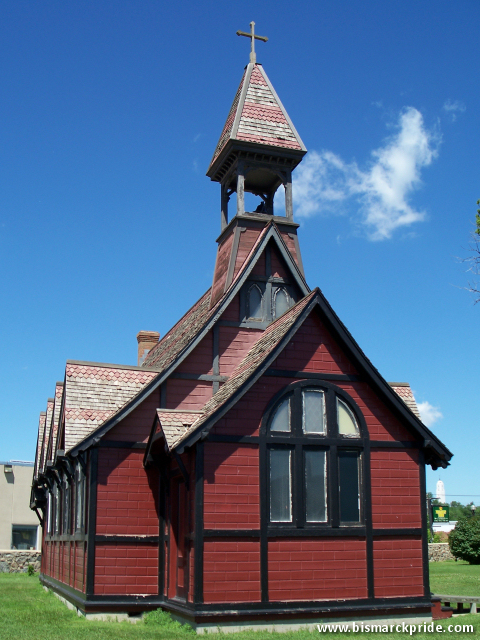Camp Hancock is a historical site and museum operated by the State Historical Society of North Dakota. It is located on Main Avenue near 1st Street.
The site contains Bismarck’s oldest surviving building, built in 1872, along with an original 1909 Northern Pacific Railroad Locomotive and North Dakota’s oldest existing church, the Bread of Life Church (St. George’s Episcopal), completed in 1881.
From 1872-1877, the camp served as a military post and supply depot supporting railroad development, supplementing nearby Fort Abraham Lincoln. From 1877-1894, it served as Quartermaster’s Office and Signal Station. It housed the U.S. Weather Bureau from 1894-1940. It was also the site of Bismarck’s first school.
Camp Hancock was was designated as a historic site on October 12, 1955.
Early History: 1872-1877

Camp Hancock, circa 1872-1875. Bismarck’s oldest surviving building is located here. Credit: State Historical Society of North Dakota (00095-00048-02)
Camp Hancock’s original purpose was a supply depot and infantry post to support development of the Northern Pacific Railroad.
Establishment of the camp was authorized on April 16, 1872 when the Saint Paul-based Headquarters of the Department of Dakota issued Special Order No. 65. The order appointed a board of directors, including Doctor Benjamin Slaughter, to select a site for the location of a support depot within the “immediate vicinity of the point where the railroad would cross the river.” It replaced Camp Greene, which was located at the mouth of the Little Heart River, three miles south of where where Fort McKeen would be established.
The camp was formerly occupied on August 8th, 1872 when officers arrived aboard the Ida Stockdale.
It was originally called Camp Greeley, named for journalist Horace Greeley – the liberal presidential candidate running against President Grant. General Sheridan opposed naming of the camp after Greeley and ordered the name to be changed. By the time General George Winfield Scott Hancock visited on October 7, 1872, the post was renamed Camp Hancock in his honor.
Its occupation marked the first significant settlement in what would become Bismarck. Several structures were erected that fall, comprising of log buildings and tents. One of the original log buildings, which has since been covered by clapboard siding and expanded several times, still remains at the site as the city’s oldest surviving building.
While there is no doubt that the city’s oldest building is that at Camp Hancock, there are varying account as to when it was built, and by whom. Most accounts state that it was one of the initial buildings erected in the fall of 1872, but some do indicate it wasn’t constructed until 1873. At least one other article says that the first two buildings on the site were those commissioned by Doctor Burleigh ahead of the camp’s occupation, including his warehouse and home. No firm records prove the date without reasonable doubt.
Linda Slaughter – whose husband was the camp’s post-surgeon – established Bismarck’s first school at Camp Hancock in the fall of 1872. It was a Presbyterian Sunday school called Sabbath School.
The local weather bureau was first housed on the site in 1874.
Camp Hancock’s purpose as an occupied infantry encampment ceased on April 12, 1877. The weather bureau also relocated at this time, but would soon return.
Later Use
From 1877-1894, Camp Hancock served as the Quartermaster’s Office and Signal Station. Then from 1894-1940, Camp Hancock housed the U.S. Weather Bureau. The Department of Agriculture used the facility until 1949, when it was gutted by a major fire caused by the furnace. At that time, the building was donated to the State Historical Society, who began restoring the damaged building.
Camp Hancock was designated as a historic site on October 12, 1955. The vintage 1909 Northern Pacific Railroad steam locomotive was donated to the site during its dedication ceremony. The locomotive underwent restoration in 2010, which included a long-awaited shelter. The Bread of Life Church was added to the site in 1965.
Image Gallery
- Camp Hancock in 2009
- Camp Hancock in 2009
- Camp Hancock in 2009
- Northern Pacific Locomotive #2164
- Camp Hancock Site in 2011
- Camp Hancock Site in 2011
- Bread of Life Church in 2009
- Bread of Life Church in 2009
- Bread of Life Church in 2009
- Vintage Northern Pacific Railroad Locomotive and Bread of Life Church
- Vintage 1909 Northern Pacific Railroad Locomotive
- Vintage 1909 Northern Pacific Railroad Locomotive
- Vintage Northern Pacific Railroad Locomotive and Bread of Life Church
- Vintage Northern Pacific Railroad Locomotive and Bread of Life Church
- Inside Camp Hancock Museum
- Inside Bread of Life Church, completed in 1881.
- Inside Bread of Life Church
- Inside Bread of Life Church, completed in 1881.
- Inside Bread of Life Church, completed in 1881.
- Locomitive Shelter Dedication in 2011
- Locomitive Shelter Dedication in 2011
- Locomitive Shelter Dedication in 2011
- Locomitive Shelter Dedication in 2011
- Locomitive Shelter Dedication in 2011
- Locomitive Shelter Dedication in 2011
- Camp Hancock Historic Site
- Camp Hancock Historic Site





























